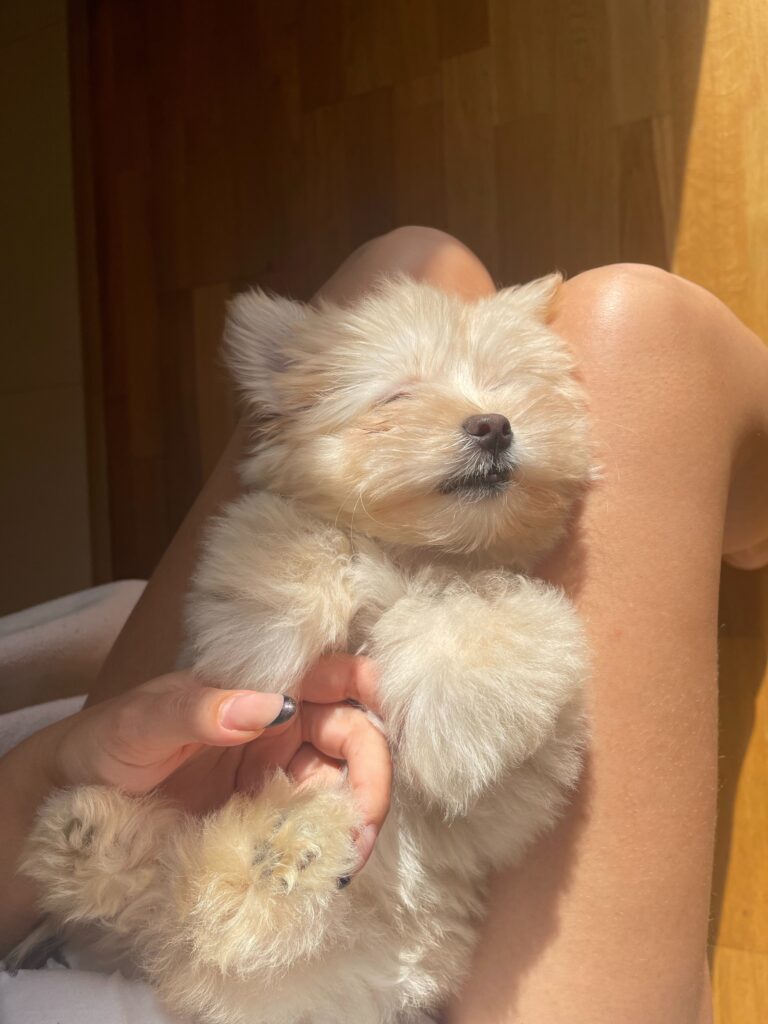Dogs engaging in humping behavior can sometimes leave their owners puzzled and even embarrassed. When a dog humps his bed, it is important to understand that this behavior is not necessarily related to sexual arousal or dominance.
Instead, it can stem from various other factors. Dogs may hump their beds as a way to relieve stress, express excitement, or seek attention. It can also be a self-soothing mechanism or a display of excess energy.

Additionally, neutered or spayed dogs may still exhibit this behavior as it has become a learned habit.
Understanding the underlying reasons behind this behavior can help owners address it appropriately with patience and training.
But first here look up what can you spray when your dog chews your bed.
Why Do Dogs Hump?
Dogs hump for a variety of reasons, and it’s important to understand that it’s not always about sexual behavior. Humping can be a normal part of canine social interaction, especially during play.
It can also be a display of excitement or an attempt to establish dominance. In some cases, dogs may hump objects or people as a form of self-soothing or stress relief.
Additionally, hormonal changes, such as those that occur during adolescence or due to medical conditions, can contribute to humping behavior.
Neutering or spaying can reduce the frequency of humping, but it may not eliminate it entirely. Proper training and redirecting the behavior towards more appropriate outlets can help manage this behavior.
Why Do Dogs Hump When They Are Fixed?
When dogs are fixed (neutered or spayed), their sexual hormones are altered, which can affect their behavior. Humping is a natural behavior in dogs, and it can have various motivations, including sexual and non-sexual ones.
While fixing a dog can reduce or eliminate sexual motivations for humping, it doesn’t necessarily eliminate the behavior entirely.

Dogs may continue humping due to learned habits, dominance display, excitement, or even stress. It’s important to note that humping can occur in both neutered and intact dogs, and it’s not always related to sexual behavior.
If humping becomes a problem, consulting with a veterinarian or animal behaviorist can help address the underlying cause.
Now let’s move to some reasons why dogs really hump their bed?
12 Common Reasons Why Your Dog Humps His Bed
1. Your Dog is Being Playful
One common reason why dogs hump their bed is because they are being playful. Playful humping in dogs is often a form of social interaction and can be seen as a playful behavior similar to jumping or wrestling.
Dogs may exhibit this behavior when they are excited or trying to initiate play with their bed or other objects.
It’s important to provide alternative outlets for play, such as interactive toys or games, to redirect their energy and prevent excessive humping behavior.
Here check out why does my dog sneak into bed at night?
2. Your Dog is a Dominant Breed Type
The second common reason why dogs hump their bed is if they belong to a dominant breed type. Certain dog breeds have a tendency to exhibit more dominant behaviors, and humping can be one way for them to assert their dominance.
Bed humping in these cases may be a display of their status and an attempt to establish control over their environment.
It’s essential for owners of dominant breed dogs to provide consistent training, establish clear boundaries, and ensure proper socialization to manage their dominant tendencies effectively.
3. Your Dog is Experiencing Medical Issues
The third common reason why dogs hump their bed is if they are experiencing medical issues. Humping behavior in dogs can sometimes be a sign of underlying medical conditions, such as urinary tract infections, skin allergies, or hormonal imbalances.
These conditions can cause discomfort or irritation, leading to increased humping as a response.
It’s crucial to monitor your dog for any other symptoms, consult with a veterinarian, and have a thorough medical examination to rule out any potential health issues contributing to the humping behavior.
4. Your Dog is Anxious
The fourth common reason why dogs hump their bed is if they are anxious. Humping can be a self-soothing behavior for dogs experiencing anxiety or stress.
It helps them release pent-up energy and cope with their emotions. Anxious dogs may hump their bed as a way to comfort themselves or seek reassurance.
It’s important to address the underlying anxiety through behavior modification techniques, providing a calm environment, and, if necessary, consulting with a professional dog trainer or a veterinarian to develop a comprehensive plan to reduce anxiety and alleviate the humping behavior.
Here look up why does my dog sleep at the end of the bed?
5. Your Dog is Bored
The fifth common reason why dogs hump their bed is if they are bored. Dogs may engage in humping behavior as a means of seeking stimulation or entertainment when they lack mental and physical activities.
Humping can be a self-rewarding behavior that provides temporary excitement. To address this, it is important to ensure that your dog receives adequate exercise, playtime, and mental stimulation.
Providing interactive toys, engaging in regular training sessions, and offering puzzle games can help alleviate boredom and reduce the likelihood of bed humping as a result. Here why does your dog lick your bed sheet?
6. Your Dog is Seeking Attention
The sixth common reason why dogs hump their bed is if they are seeking attention. Dogs may hump their bed as a way to gain your attention, especially if they have learned that this behavior elicits a response from you.
They may resort to humping to get petting, playtime, or simply to engage with you.
To address this, it’s important to provide ample attention and quality time with your dog, reinforcing positive behaviors, and redirecting their focus onto appropriate activities that fulfill their need for interaction and attention.
7. Hormonal Changes
The seventh common reason why dogs hump their bed is due to hormonal changes. Hormones play a significant role in a dog’s behavior, including their humping tendencies.
Hormonal fluctuations, such as during puberty or heat cycles in intact dogs, can increase sexual motivations for humping.
Additionally, even after being spayed or neutered, some dogs may still experience residual hormonal effects, leading to continued humping behavior.
While hormonal changes are a natural cause, it’s important to manage the behavior through training, redirection, and providing appropriate outlets for their energy. Here how to put your dog to bed?
8. It Feels Good
The eighth common reason why dogs hump their bed is simply because it feels good. Humping can provide dogs with physical stimulation and gratification.
The action releases endorphins and may offer a pleasurable sensation.
This behavior is not necessarily related to sexual motivations but rather a form of self-stimulation. Dogs may engage in humping as a way to experience sensory satisfaction or as a self-rewarding behavior.
Providing appropriate outlets for physical and mental stimulation, such as exercise and interactive toys, can help redirect this behavior in a more desirable manner.
9. They Are Overly Stimulated
The ninth common reason why dogs hump their bed is when they are overly stimulated. Excessive excitement or arousal can trigger humping behavior in dogs.
This can occur when they are in a highly stimulating environment, such as during playtime or when encountering new people or animals. Humping serves as a way for them to release and redirect their heightened energy.
It’s important to provide structured and calm environments for your dog, incorporating regular exercise and mental enrichment, to prevent excessive stimulation and reduce the likelihood of bed humping as a result.
10. They Are Testing You
The tenth common reason why dogs hump their bed is when they are testing you. Dogs are intelligent animals and may engage in humping behavior as a way to assess your response or establish their dominance.
By observing how you react, they can gauge their control over you or the household. It’s crucial to establish consistent boundaries and assert your role as the leader through positive reinforcement training.
By providing clear guidance and reinforcing desired behaviors, you can discourage the behavior of humping to test you.
11. It’s A Habit
The eleventh common reason why dogs hump their bed is that it has become a habit. Dogs are creatures of habit, and if humping has been reinforced or rewarded in the past, they may continue the behavior out of habit.
It could be a learned response from their previous experiences or a repetitive behavior that provides a sense of comfort.

To break this habit, it’s important to redirect their attention to more appropriate activities, provide mental and physical stimulation, and discourage the humping behavior consistently through positive reinforcement and redirection.
12. It’s Stress-Related
The twelfth common reason why dogs hump their bed is that it is stress-related. Humping can be a coping mechanism for dogs experiencing stress or anxiety.
Stressors such as changes in the environment, separation anxiety, or unfamiliar situations can trigger this behavior. Humping provides a temporary release of tension and can serve as a self-soothing mechanism for the dog.
To address stress-related humping, it’s important to identify and minimize the sources of stress, provide a calm and secure environment, and consider professional guidance from a veterinarian or animal behaviorist to develop a comprehensive stress management plan for your dog.
Why does my dog hump his bed after dinner?
Excitement
One possible reason why your dog humps his bed after dinner is due to excitement. After eating, dogs may experience a surge of energy and excitement.
Humping behavior can be a way for them to release this excitement and express their enthusiasm. It’s similar to how dogs might jump or run around after a meal.
Providing alternative outlets for their post-dinner excitement, such as playtime or a walk, can help redirect their energy and reduce the likelihood of humping behavior.
Comfort
One possible reason why your dog humps his bed after dinner is for comfort. Humping can provide a sense of security and relaxation for some dogs.
After a meal, they may seek out their bed as a comfortable spot and engage in humping behavior as a way to self-soothe and find contentment.

It’s important to ensure that your dog has a cozy and comfortable bed, and if the humping becomes excessive or bothersome, providing alternative forms of comfort, such as a soft blanket or a designated relaxation area, may help redirect their behavior.
Habit
One possible reason why your dog humps his bed after dinner is out of habit.
Dogs are creatures of habit and can develop routines and behaviors that become ingrained over time. If your dog has engaged in humping behavior after dinner in the past, it may have become a learned habit.
Even if no specific trigger or underlying motivation exists, the association between dinner and humping has been established.
Breaking this habit may require consistent redirection, providing alternative activities, and reinforcing desired behaviors.
Why does my dog hump his bed at night?
Anxiety
One possible reason your dog humps his bed at night is anxiety. Dogs may experience heightened anxiety or restlessness during nighttime, which can lead to humping behavior as a way to cope or seek comfort.
Factors such as fear of darkness, separation anxiety, or unfamiliar noises in the environment can contribute to nighttime anxiety.
Creating a calm and secure sleeping environment, providing a comfortable and safe space, and considering anxiety-reducing techniques, such as soothing music or a bedtime routine, may help alleviate your dog’s anxiety and reduce the humping behavior at night.
Privacy
One possible reason why your dog humps his bed at night is for privacy. Dogs have natural instincts to find a secluded and safe space to engage in certain behaviors.
Humping their bed at night could be their way of seeking privacy and creating a personal space for themselves. It may provide them with a sense of comfort and security.
Ensuring that your dog has a designated and cozy area where they feel secure can help address their need for privacy and potentially reduce the humping behavior at night.
Boredom
One possible reason why your dog humps his bed at night is due to boredom. Dogs that lack mental and physical stimulation can exhibit repetitive or self-rewarding behaviors, such as humping.
At night, when activity levels may be lower, dogs may resort to humping their bed as a way to alleviate boredom and expend excess energy.
Providing ample opportunities for exercise, play, and mental enrichment throughout the day, as well as interactive toys or puzzle games at night, can help alleviate boredom and reduce the humping behavior.
Why does my dog hump his bed after a walk?
Overly Stimulated
One possible reason why your dog humps his bed after a walk is that he is overly stimulated. Going for a walk can be an exciting and stimulating experience for dogs, especially if they encounter other animals, new scents, or engaging environments.
This heightened arousal can lead to excessive energy that needs to be released. Humping behavior after a walk may be a way for your dog to channel that excess stimulation and release the pent-up energy.
Providing additional physical and mental stimulation outlets, such as playtime or interactive toys, can help redirect their energy and reduce the humping behavior.
Anxious
Anxiety is one possible reason your dog humps his bed after a walk. Walking can sometimes trigger anxious feelings in dogs, especially if they are exposed to unfamiliar environments, encounters with other dogs, or loud noises.
Humping behavior can serve as a coping mechanism to relieve stress or anxiety. It may provide a temporary sense of comfort and help them regulate their emotions.
If the humping behavior persists and is accompanied by other signs of anxiety, it may be beneficial to consult with a veterinarian or professional dog behaviorist to address the underlying anxiety and provide appropriate strategies for managing it.
Happiness
One possible reason why your dog humps his bed after a walk is because he is happy. Humping can be a way for dogs to express their joy and excitement.
After a walk, your dog may be experiencing a surge of positive emotions and engaging in humping behavior as a way to release that happiness.
It can be similar to other exuberant behaviors such as zooming around or jumping. If the humping is not excessive or causing any issues, it may simply be a manifestation of your dog’s happiness and enthusiasm.
Not Ready for Walk to End
One possible reason why your dog humps his bed after a walk is because he is not ready for the walk to end. Dogs often enjoy the stimulation, exercise, and exploration that come with going for a walk.
Humping their bed after a walk can be a way for them to continue engaging in an activity that they find enjoyable. It may be a sign that your dog is still full of energy and wants to extend the experience.
Ensuring that your dog receives sufficient exercise and mental stimulation during the walk, and providing additional outlets for play and enrichment afterward, can help address their desire to prolong the activity and reduce the humping behavior.
When is Humping the Bed a Problem?
Humping the bed can become a problem when it becomes excessive, disruptive, or causes distress to the dog or the owner. Some situations in which humping the bed may be problematic include:
- Damaging the bed or other furniture.
- Interfering with daily activities or preventing relaxation.
- Displaying aggression or possessiveness when approached while humping.
- Humping in inappropriate contexts, such as in public or in front of guests.
- Causing physical discomfort or injury to the dog.
- Indicating underlying medical issues or behavioral problems that need attention.
If humping becomes a persistent or problematic behavior, it’s advisable to consult with a veterinarian or professional dog behaviorist to determine the underlying cause and develop an appropriate management or treatment plan.
Can You Train Your Dog to Stop Humping?
Yes, it is possible to train your dog to stop humping. Training methods can help redirect the behavior and teach your dog more appropriate alternatives. Here are some steps to consider:
- Identify triggers: Determine what triggers the humping behavior and try to address those triggers.
- Interrupt and redirect: When you catch your dog humping, use a verbal cue or gentle physical interruption to stop the behavior. Redirect their attention to a more acceptable behavior, such as sitting or playing with a toy.
- Reinforce alternative behaviors: Reward and praise your dog when they engage in appropriate behaviors instead of humping. This positive reinforcement helps to reinforce desired actions.
- Provide mental and physical stimulation: Ensure your dog receives enough exercise, playtime, and mental stimulation to prevent boredom and reduce the likelihood of humping due to excess energy.
- Consistency and patience: Training takes time and consistency. Be patient with your dog and consistently reinforce the desired behavior.
- Seek professional help if needed: If the humping behavior persists or becomes problematic, consult with a professional dog trainer or behaviorist who can provide specialized guidance and techniques tailored to your dog’s specific needs.
Thus, every dog is different, and it may take time and effort to modify the behavior. Positive reinforcement, consistency, and patience are key to successfully training your dog to stop humping.
Is it okay to let your dog hump?
Allowing your dog to hump can depend on the context and individual circumstances. While humping is a natural behavior in dogs, it may not always be appropriate or desirable.
It can be a concern if it causes discomfort or distress to the dog or others. It’s important to consider the specific situation, the dog’s behavior, and the impact on their well-being and the environment.
If humping becomes excessive, disruptive, or causes problems, it’s advisable to address the behavior through training and redirection.
Pros of Letting Your Dog Hump
Allowing your dog to hump can have some potential benefits. It can serve as a natural form of self-expression and play behavior, providing an outlet for energy and excitement.
In some cases, humping can be harmless and not cause any issues. Additionally, for intact dogs, humping may be a way to engage in normal sexual behavior.
However, it’s important to consider the context, individual dog’s behavior, and the comfort of people or other animals involved. It’s advisable to monitor the behavior and intervene if it becomes excessive, disruptive, or causes discomfort.
Cons of Letting Your Dog Hump
Allowing your dog to hump can have several drawbacks. It may encourage inappropriate behavior, especially if directed towards people or other animals without their consent. Allowing humping without addressing it can lead to social awkwardness or discomfort in public settings.
Additionally, it can indicate underlying behavioral issues, such as dominance or anxiety, which should be addressed for the overall well-being of the dog.
It’s important to set boundaries, redirect the behavior, and provide appropriate physical and mental stimulation outlets to discourage excessive or unwanted humping.
How to stop when you dog hump his bed?
Check for Physical Issues
To stop your dog from humping his bed, start by checking for any physical issues that might be causing discomfort or irritation.
Look for signs of skin allergies, infections, or discomfort in the genital area. If you notice any abnormalities or suspect a medical issue, consult with a veterinarian for a thorough examination.
Treating any underlying physical problems can help alleviate the humping behavior.
Also, maintaining proper hygiene and cleanliness of the bedding can reduce the likelihood of irritation and discourage humping.
Are Your Dog’s Needs Being Met?
Anxiousness or Stress
If your dog is displaying anxiousness or stress, it’s essential to evaluate whether their needs are being met. Dogs require proper physical and mental stimulation, social interaction, and a safe and comfortable environment.
Ensure they receive regular exercise, playtime, and mental enrichment activities. Adequate socialization and positive experiences are also crucial.
Create a calm and predictable routine, provide a designated quiet space, and consider anxiety-reducing techniques such as pheromone diffusers or soothing music.
Meeting these needs can help alleviate anxiousness or stress and reduce the likelihood of behaviors like humping their bed as a coping mechanism.
Behavioural Training
When assessing if your dog’s needs are being met, behavioral training plays a significant role. Training helps establish clear communication, boundaries, and expectations for your dog.
By implementing positive reinforcement techniques, you can encourage desirable behaviors and discourage unwanted ones, such as humping their bed. Through consistent training, you can redirect their focus to appropriate activities and provide mental stimulation.
Training also strengthens the bond between you and your dog, enhancing their overall well-being and helping address behavioral issues that may contribute to humping behavior.
Don’t Give Them the Opportunity to Hump
When assessing if your dog’s needs are being met, it’s important to consider whether you are inadvertently giving them the opportunity to hump.
Ensure that you’re not providing situations or objects that trigger or enable the behavior. Monitor your dog’s environment and supervise their interactions to prevent humping situations. Redirect their focus onto more appropriate activities, such as playtime or training exercises.
By eliminating the opportunity for humping and providing alternative outlets for their energy and attention, you can help discourage the behavior and promote a more desirable set of behaviors in your dog.
Remove the Bed
If you notice that your dog’s needs are not being met and they continue to hump their bed, one option is to remove the bed altogether.
Humping behavior may be reinforced if the bed is readily available and serves as a trigger. Instead, provide your dog with a comfortable, designated resting area that doesn’t resemble a bed. This can help break the association between humping and the specific object.
Additionally, focus on addressing your dog’s needs through exercise, mental stimulation, social interaction, and positive reinforcement training to discourage the humping behavior overall.
Get them Spayed or Neutered
When evaluating if your dog’s needs are being met, consider getting them spayed or neutered if they haven’t been already. Spaying or neutering your dog can have several benefits, including reducing hormonal influences that may contribute to humping behavior.
It can help decrease sexual motivations, minimize the desire to mark territory, and potentially reduce certain aggressive tendencies.
However, it’s important to note that spaying or neutering alone may not completely eliminate humping behavior, as other factors such as learned habits or stress can still play a role.
Consulting with a veterinarian can provide valuable insights and guidance regarding the benefits and timing of spaying or neutering for your specific dog.
Related faq’s
Why is my dog mounting his bed?
Mounting or humping behavior in dogs can have various underlying reasons. It can be a natural behavior, a form of play, an expression of excitement, a display of dominance, or even a response to stress or anxiety.
Dogs may also mount their beds due to hormonal influences, learned habits, or seeking comfort.
It’s important to observe your dog’s behavior, consider any triggers or patterns, and consult with a veterinarian or professional dog behaviorist to determine the specific cause and develop an appropriate plan to address the mounting behavior.
Should I let my puppy hump his pillow?
It is generally not recommended to allow your puppy to hump his pillow. Humping behavior in puppies may be driven by various factors, including exploration, playfulness, or an attempt to assert dominance.
Allowing this behavior can reinforce and establish a habit that may continue into adulthood.
It’s best to redirect your puppy’s attention to more appropriate activities, provide mental and physical stimulation, and discourage humping behavior from an early age to promote desirable behaviors and prevent potential problems in the future.
Why does my dog want to hump every night?
There can be several reasons why your dog wants to hump every night. It could be due to excess energy that builds up throughout the day and is released through humping.
Hormonal factors, such as intact dogs experiencing reproductive urges, can also contribute to nightly humping.
Additionally, if your dog is experiencing anxiety or stress, humping may serve as a self-soothing mechanism.
Understanding the underlying cause, providing proper exercise, mental stimulation, and addressing any potential anxiety or medical issues can help reduce the frequency of nightly humping behavior.
Conclusion:
In conclusion, dogs may hump their beds for various reasons. It can be a natural behavior, a way to release excess energy, a means of seeking attention or playfulness, or even a response to anxiety or stress.
Hormonal influences, dominance tendencies, boredom, or learned habits can also contribute to this behavior. While occasional humping may not be a concern, excessive or problematic humping should be addressed.
Understanding the underlying cause, providing proper exercise, mental stimulation, training, and addressing any medical or behavioral issues are essential for managing and redirecting the humping behavior.
Consulting with professionals, such as veterinarians or dog behaviorists, can provide valuable guidance for a tailored approach to address this behavior in a positive and effective manner.






